Technological processes and material science. Рубрика в журнале - Siberian Aerospace Journal
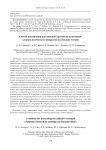
A method for increasing the adhesive strength of plasma electrolytic coatings on titanium alloys
Статья научная
The aim of the work is to develop a method for forming an MAO coating on a titanium alloy, which helps to increase the adhesive strength of the coating with the substrate and to establish the effect of the processing mode on the thickness and roughness of the coating. A method for using ultrasonic vibrations (US) during the microarc oxidation (MAO) process is proposed and studied. The described method allows obtaining a multifunctional coating by the microarc oxidation method using ultrasonic vibrations on the OT-4 titanium alloy with increased adhesive strength to the base metal. And also a uniform thickness and roughness of the coating over the entire surface of the workpiece is achieved. The positive effect of US on the adhesive strength of the coating is confirmed. A mode for processing titanium alloys by the MAO method under US and a current pulse repetition frequency of 90 Hz is proposed, which helps to increase the adhesive strength of the MAO coating by more than 60 %. Presumably, the mechanism of coating growth is that under the influence of ultrasound, hydrogen bubbles formed in the process break into smaller bubbles and intensively approach the surface of the substrate. As they grow, the bubbles burst under the influence of ultrasound and release a large amount of heat and energy, which accelerates the formation of the film. Subsequently, the cavitation effect of ultrasound decreases due to the coating and then the ultrasonic waves, due to reflection from the coating, form a standing wave at the surface, which leads to a stable distribution and compression of bubbles at the boundary of the solution and the coating. This contributes to the uniform distribution of microarcs and energy over the surface of the coating being formed. As a result, a coating of uniform thickness with less roughness and firmly bonded to the substrate material is formed.
Бесплатно
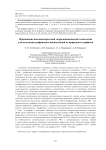
Статья научная
Carbon nanostructures have been in the focus of world science for more than 25 years, since the discovery of fullerenes in 1985, single-walled carbon nanotubes in 1993, graphene in 2004, graphene quantum dots in 2004. Graphene is a monocrystalline graphite films (2D material) with a thickness of several atoms that are stable under environmental conditions and they have excellent electronic, mechanical, chemical, thermal and optical properties. All over the world, research and development of new methods of using graphene in various fields such as energy, oil production, materials science, and electronics are actively carried out. Currently, the use of graphene-containing materials as modifiers for the creation of durable and effortless materials in aviation, automotive and other branches of engineering is an urgent problem. It is advisable to introduce graphene particles into the composition of composite materials using their stable dispersions in a liquid medium. The production of colloidal graphene suspensions is effective in many cases using the method of liquid phase exfoliation of graphite. The paper presents the results of studying the physico-chemical properties of aqueous graphene suspensions obtained by liquid-phase exfoliation of natural graphites using high-speed hydrodynamic technology. Graphite grades GK-1 and GAK-2 (Grafitservice, Chelyabinsk, Russia) are crystalline graphites obtained by enrichment of graphite ores and joint enrichment of natural graphite ores and graphite-containing waste from metallurgical industries, respectively. Graphite suspensions were prepared in distilled water with 1 wt.% graphite, surfactant was added to some samples, processing time (3–120 min), rotor rotation speed (4 000–11 000 rpm). The resulting graphene suspensions were investigated by XRD, by electron microscopy and sedimentation analysis methods. The particle size was determined using the DT-1202 electroacoustic spectrometer. The presence of multilayer graphene is confirmed by comparing the results of XRD with the literature data. Along with multilayer graphene, the presence of graphene dots was detected. Aqueous graphene suspensions for graphites with different sedimentation times have been obtained. For graphite GAK-2 – six days, for graphite GK-1 – 90 days, for graphite GK-1 + surfactant – 6 months.
Бесплатно
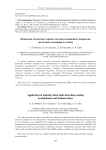
Application of optically black lightabsorbing coating on aluminum and titanium alloys
Статья научная
The paper presents an analysis of methods for obtaining an optically black light-absorbing coating by microarc oxidation on valve metal alloys. The formulation of a universal electrolyte and processing modes for the formation of an optically black coating on aluminum and titanium alloys are revealed. The dependences of the parameters of the processing modes on the properties of coatings are established. The resulting oxide layer has a high degree of blackness and has a homogeneous structure. The results of the study can be used when applying optically black MDO coating on products of rocket and space technology.
Бесплатно
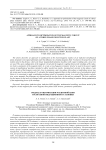
Approach to optimization of the magnetic circuit of a three-phase induction plant
Статья научная
The article describes an approach to optimization of the electromagnetic regimes of an induction metallurgical plant, designed to mix liquid aluminum under the influence of a running magnetic field. To improve the properties of the molten metal in the furnace, short pole linear magnetohydrodynamic machines with copper windings and a steel core are used. The open configuration of the magnetic circuit and the magnetic coupling between the windings of the inductor lead to asymmetry of the magnetic field. As a rule, a low-frequency transistor inverter is used in the power supply system of metallurgical machines intended to affect non-ferrous metals. Asymmetrical currents in the phases create specific modes of the frequency converter, close to emergency, and a two-phase, three-phase or multi-phase power supply system may become unbalanced. To calculate the integral magnetic fluxes in the toothed zone of an induction installation, it is convenient to apply a multiphase nonlinear model of a magnetic circuit. As a result of the iterative calculation, vector magnetic flux diagrams are obtained and the tractive forces in the melt are estimated. The best conditions for the impact on the melt are obtained with a given objective function when searching for options during optimization of the magnetizing forces of the windings.
Бесплатно
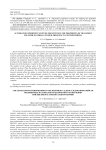
Статья научная
Recent decades have been characterized by increased activity in the use of polymer and composite materials in transport engineering. In this paper, the authors give a generalizing analysis of previously created systems of scientific research and analyze the principles of building automated systems of scientific research (ASSR) that allow solving the problems of determining the parameters of heat exchange, electrophysical parameters and phase transformations in polymer and composite materials when exposed to the HF field. The authors continue the research of the ASSR HF developed by the Irgups team, a number of other scientific schools working in the same direction.therefore, within the framework of the hardware created by these teams, both similar and original developments and solutions are viewed. The analysis of the software parts of the ASSR HF presented by a number of mathematical models and software complexes is given. Thus, the analysis of the structure of the developed systems of scientific research allows us to speak about its dynamic development. The developed and presented flowcharts of automated experiment and automated research systems allow the author to assert that the systems of automated experiment for studying the properties of polymer materials in RF electrothermia created for cer-tain tasks, despite the fact that they were conducted independently and separately, have a single construction methodology. Comparing the results of the research, the author concludes that the construction of a complex system of ASSR HF polar thermoplastic polymers is generally complete
Бесплатно
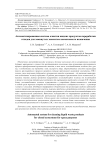
Automated system for cleaning liquid waste products for closed ecosystems for space purposes
Статья научная
Ensuring human life activity for several years in isolated conditions of future Martian and lunar bases is possible with the organization of a circular process of converting organic waste, including human exometabolites (feces . urine), into the products he needs: water, oxygen and food. A promising way to organize such a circular process is to create a three–link closed ecosystem (CES): a person, a link for obtaining fertilizers from organic waste and plants - where plants synthesize the products necessary for a person. The paper considers the original scheme of a complex installation for the purification of liquid products of processing of human exometabolites from pollutants in the process of obtaining nutrient solutions for growing plants in a CES. The processing of human exometabolites was carried out in a device for physicochemical oxidation of hydrogen peroxide in an aqueous medium under the action of alternating electric current – in a “wet” combustion reactor. Peripheral equipment was selected for the organization of the automatic control system of the cleaning plant, problems were identified and approaches were developed in the automation of technological processes and the creation of software for human interaction with the proposed installation. Experiments on the cultivation of lettuce plants have been carried out, confirming the effectiveness of the proposed processes of purification of liquid products of processing of human exometabolites. It is concluded that the created integrated cleaning plant, equipped with the proposed software, can be used for scientific research in relation to the subject of CES, including space purposes.
Бесплатно
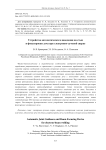
Automatic Joint Guidance and Beam Focusing Device for electron-beam welding
Статья научная
Physical, technological and power characteristics of the Electron Beam Welding (EBW) support its application in those circumstances that require greater focus on features and quality of the welding joints and improved weight and robustness aspects for individual joints of an object and products as a whole. At the same time, those characteristics of the EBW establish it as a complicated process that results from multiple factors interacting with one another. The quality of a welding joint depends on the precision of the beam alignment with the joint plane and the positioning of the minimum section (focus) of the electron beam in the penetration channel. These factors have a significant impact on the welding depth, the shape of the seam and presence of defects in it. The challenge of providing precise positioning of the beam along the joint of the welded parts is especially critical during the welding of long joints of large construction parts. This level of precision requires reliance on equipment for automatic beam alignment with the seam. Dispersion and re-reflection of the electrons in the beam leads to the loss of focus for the beam at a stable current of the focusing system. To obtain the data for the beam’s position at the seam and the position of the beam’s focus at the welding surface, we use phenomena closely associated with the EBW, such as the secondary electron emission and the X-ray radiation in the welding area. We are presenting a functional diagram of a device for the automatic positioning and focusing of the electron beam.
Бесплатно
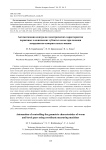
Статья научная
The paper contains the results of research on the automation of controlling the geometric characteristics of gears. The use of coordinate measuring machines can significantly increase the productivity and accuracy of measurements. However, their use for controlling gears requires the application of special programs for carrying out and processing measurement results of products with complex surface shapes. The use of software for metrological control of the geometric characteristics of worm and bevel gears makes it possible to achieve high accuracy of control and measurement work. To automate the control of geometric characteristics of worm and bevel gears, an additional module has been created for the standard program. With its help, all points of the measured curved surface of gears, obtained by contact method according to a standard measurement program, are structured into a single data array with a measurement protocol. On the basis of these data, the module generates a profile of the measured surface of a wheel tooth and builds a geometric contour of the measured tooth profile. The result of the module's operation is the formation of a general profile of the entire gear and its comparison with the original (theoretical) profile of the gear as a whole. The control process itself is carried out in a short time interval, which makes it possible to use the proposed approach to automating the control of gear profiles in small-scale production.
Бесплатно
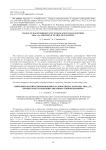
Change in magnetoresistance in manganese chalcogenides MnSe1-XTeX from bulk to thin-film samples
Статья научная
The electrical and optical properties of anion-substituted antiferromagnetic semiconductors MnSe1-ХTeХ (0.1 ≤ X ≤ 0.4) in the temperature range 77-300 K and magnetic fields up to 13 kOe in bulk samples and in poly-crystalline thin films are investigated. Negative magnetoresistance was found in the MnSe1-XTeX solution in the neighbourhood with a Néel temperature for X = 0.1 and for a composition with X = 0.2 in the paramagnetic re-gion up to 270 K. A correlation was established between the spin-glass state and magnetoresistance for X = 0, 1 and 0.2. The opti-cal absorption spectra were measured in the frequency range 2000 cm-1 < ω < 12000 cm-1. A decrease in the gap in the spectrum of electronic excitations and a several of absorption peaks near the bottom of the conduc-tion band were found. Coexistence of two crystalline phases was found in polycrystalline films of the MnSe1-XTeX system by X-ray diffraction analysis. Resistance maxima were established in the region of polymorphic and magnetic transitions. A model of localized spin-polarized electrons with a localization radius varying in a magnetic field as a result of competition between ferromagnetic and antiferromagnetic interactions is proposed. In the paramagnetic region, negative magnetoresistance is caused by tunneling of spin-polarized electrons during orbital ordering.
Бесплатно

Contact algorithm measurement method for current crystals area grown by Czokhralski method
Статья научная
For crystals grown from the liquid melt according to the Czochralski method when monitoring and controlling the current crystal area based on the contact measurement method, the requirements for improving the accuracy of measuring the crystal area on the cylindrical part of the growth are determined. To eliminate errors due to the accuracy of stabilization of the melt level in the crucible, an algorithm for the operation of the crystal growing unit is proposed which is performed by the programm using the control system. The evaluation time of the control signal on the growing crystal cylindrical part is taken as the sampling time of a given number of crucible movement pulses. The calculation of the control signal starts at the time of the melt level sensor closure, the calculation of the control signal ends at the time of the melt level sensor closure as well, provided that a given number of crucible movement pulses is sampled. The control signal evaluation time in the previous control cycle is used in the current cycle to calculate the melt level sensor closing and opening pause. In the control system at the moment of the contact sensor closure a pause of the closed and the same subsequent pause of the open state of the level sensor is held. During pauses, the status of the contact sensor is not analyzed by the control system and the control of the crucible ascent occurs at a slowed down and accelerated rate of the crucible ascent during “conditionally” closed and “conditionally” open states of the level sensor. The control system is permanently reset at the end of each control cycle. The program control system provides the above algorithm for controlling the process of growing crystals from the liquid melt according to the Czohralski method, at the same time the accuracy of determining the current area of the grown crystal is about 1 %.
Бесплатно
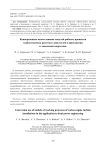
Статья научная
In this paper, we consider the concept of using methods for calculating and designing rocket engine power plants for conversion modeling of local energy in the Arctic and northern regions of the Kras-noyarsk Territory, with an obvious generalization to neighboring administrative formations with similar climatic and structural and logistical conditions. The proposed structure contains power generation units linked to both industrial woodworking waste and natural and industrial thermal tails, identified as sources of low-potential heat, as well as modern low-power reactor plants of block maintenance-free design. The unifying element of power plants is a turbo generator, designed with the use of unconventional, often waste and natural low-grade heat.
Бесплатно
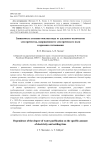
Статья научная
The known methods of treatment of wastewater generated in rocket and space technology production using electroplating technologies do not allow to ensure the maximum permissible concentration of metal ions in treated water, or are expensive or difficult to operate. The general toxic, embryotropic and muta-genic effect of metals is well studied. These metals, getting together with water to food products in living organisms, are able to accumulate in them, causing the pathogenesis of heart diseases, brain, liver, and cancerous tumors in people. Iron ions are part of wastewater of most industries, which requires increased control and development of effective methods of wastewater treatment. The article presents a technique for conducting experiments, a method of combined water purification, including electrochemical action and adsorption, is considered. The results of studies of this method of wa-ter purification from iron ions are presented. The dependence of the degree of purification on the specific amount of electricity passing through the purified water, the strength of the electric field and the settling time is revealed. With Qav = 4.7 Kl/l, E = 1058 V/m, using quartz sand as an adsorbent and settling time for 24 hours, the concentration of iron ions decreased from 1.65 to 0, 82 mg/l. The proposed combined cleaning method requires inexpensive and affordable materials and is easy to operate.
Бесплатно
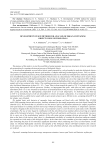
Development of SEM method for analysis of organ-containing objects using inverse opals
Статья научная
The purpose of this study is to test the possibility of using inorganic macroporous structures of inverse opal in sample preparation for scanning electron microscopy of biological objects. As an absorbent substrate we used silica inverse opals prepared by a sol-gel method to study the biological objects. The process of manufacturing the inverse opal involves a complex multi-stage technological process. First, we synthesized submicron spherical particles from polymethylmethacrylate by the method of emulsifier-free emulsion polymerization of methylmethacrylate in an aqueous medium in the presence of a diazoinitiator. This method can be used to obtain an ensemble of particles with high monodispersity, the average size of which can vary in the range from 100 to 500 nm. Then, by self-assembly technique, we deposited the beads of polymethylmethacrylate into ordered matrices (templates), mainly with a face-centered cubic lattice. The resulting mesoporous structures, called artificial opals or colloidal crystals, had lateral dimensions of about 10 × 10 × 2 mm. Then we heat-treated the opals to 120 °C to harden the template before being impregnated with the precursor. Further, we impregnated the opals with silica sol with a particle size distribution from 1 to 5 nm, obtained by hydrolysis of tetraethoxysilane in the presence of hydrochloric acid, and then, after curing and drying the impregnating composition in air at room temperature, we multi-stage fired them up to 550 °C at normal pressure in the air atmosphere to remove all organic components. As a result, the macroporous metamaterial (the so-called inverse opals) with an open system of pores up to 400 nm in size, occupying about 80 % of the volume, were obtained. We studied lactic acid bacteria of cucumber brine and human red blood cells with TM4000 Plus, SU3500 and S-5500 scanning electron microscopes. Auxiliary substance for the sample preparation was ionic liquid VetexQ EM (Interlab LLC). We showed that it is possible to use the inverse opal as an absorbent substrate for sample preparation and rapid analysis in scanning electron microscopy without pre-drying, chemical treatment, or temperature exposure. To improve imaging in the electron microscope, we used sputter coater to cover the inverse opal surface with a thin film of platinum. The use of ionic liquid in combination with the absorbent porous medium allows preserving an original shape of the biological structures. Using the human red blood cells and lactic acid bacteria, we showed that it is possible to carry out of the morphological analysis of the cells using various scanning electron microscopes. We found that on the basis of the inverse opal, there is a fundamental possibility of creating the absorbent substrate suitable for repeated use in the study of the biological objects. At the same time, trace remnants of previous samples remaining after annealing the plate do not introduce significant distortions when conducting new series of observations. In this study, we obtained high-quality electronic micrographs of the biological objects with high resolution and contrast. At the same time, due to the use of the inverse opals as the absorbent substrate, time and financial costs for research are reduced.
Бесплатно
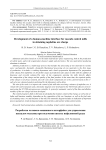
Development of a human-machine interface for cascade control mills in obtaining nepheline ore charge
Статья научная
Aluminum and alloys based on it are the main materials for space engineering, both in the production of vehicle parts, and in the organization of power supply and electronics. The raw material for producing aluminum is alumina. Alumina production is a multi-stage process that includes the processing of raw materials in various ways: mechanically, thermally, chemically. Mechanical processing of raw materials is the first stage of production, it includes a crushing department and a batch preparation department. The preparation of the charge from nepheline ore for further stages of production takes place in mills with the addition of limestone and recycled solution. The ratio of the components entering the mills directly affects the composition of the charge and the quality of the final product. At the same time, the required quality of the charge is not always ensured, since the costs of the components are set by a person based on the re-sults of a rare chemical analysis performed by the laboratory with a delay. The aim of the work is to improve the control of the mill when receiving a mixture of nepheline ore. A virtual mill control program and a mnemonic diagram were developed in the TIA Portal software environ-ment using the S7-1500 microprocessor controller. A system for automatic control of the lime and alkaline modules of the raw charge has been developed. The control program is built on the basis of calculating the moisture content of the charge, as well as the al-kaline and limestone modules, depending on the composition of the ore, limestone, as well as the feed rates of circulating water, ore and limestone to the mill. The mnemonic diagram includes an indication of important process parameters, trends in input and output characteristics, and tools for setting control actions.
Бесплатно
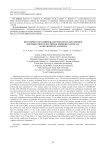
Статья научная
Aluminum-based alloys are widely used in many branches of modern industry (aviation, mechanical engineering, shipbuilding, instrument-making, energy and medicine, etc.). The promising method for further expanding the scope of these alloys is surface treatment based on the use of concentrated energy fluxes (laser beams, plasma flows, powerful ion beams, continuous and pulsed electron beams). The purpose of this paper is to establish the possibilities of integrated electron-ion-plasma modification of the structure and properties of the surface layer of technically pure aluminum A7. The surface alloy was formed in a single vacuum cycle using the “KOMPLEX” facility (ISE SB RAS) by spraying a titanium film with a thickness of 0.5 μm and the subsequent irradiation with an intense pulsed electron beam in the aluminum melting mode. After 20 “spraying/irradiation” cycles, nitriding (540 °C, 8 h) of the formed surface alloy was performed in a low-pressure gas discharge plasma using the plasma generator “PINK”. Surface alloy studies were carried out applying the modern materials science methods (scanning and transmission electron diffraction microscopy, X-ray phase analysis, determination of hardness and wear resistance). The choice of elements alloying the surface layer of aluminum was based on the analysis of binary state diagrams of Al-N, Al-Ti, Ti-N systems and the isotermal section of the ternary system Al-Ti-N. It has been shown that formation of an entire series of binary and ternary compounds, including MAX-phases of the composition Ti2AlN and Ti4AlN3, is observed under equilibrium conditions in the Al-Ti-N system. The carried out research has allowed to state that an integrated method of electron-ion-plasma modification of technically pure A7 aluminum by nitriding (540 °C, 8 h) of the surface alloy formed by pulsed melting in vacuum of the Al-Ti system (20 “spraying/irradiation” cycles with an electron beam with parameters 10 J/cm2; 50 μs; 10 pulses; the titanium film thickness in each cycle 0.5 μm) leads to formation of a multiphase multielement submicro-nanocrystalline surface layer up to 20 μm thick. It is shown that the mechanical (microhardness) and tribological (wear resistance and friction coefficient) properties of the formed surface layer exceed manifold the properties of the original commercially pure aluminum A7.
Бесплатно
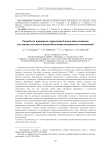
Статья научная
Exploring the Solar system by humans implies the development of long-term habitable bases on several planets: the Moon, Mars, and others. Maintaining an environment favorable for a crew on such bases is possible due to life support systems (LSS), where a closed mass transfer of products and waste is imple-mented among the crew, the higher plants and other links. Closure increases the reliability and autonomy of the system, and reduces the cost of its supply.Controlling such mass transfer appears to be a difficult technical task requiring many man-hours, which is a valuable resource in the implementation of manned space missions. In the general case, this problem is solved by means of automation, however, it is neces-sary to take into account the features of the processes that support mass transfer, since this will allow find-ing ways to simplify the hardware and logical components, increase their versatility and reliability. This article presents an analysis of the technological processes of the experimental unit for extracting NaCl from solutions of mineralized human metabolites and proposes a simple control algorithm to be used for all processes of the unit without fundamental changes. Without developing a NaCl transformation cycle, it becomes almost impossible to develop a long-term functioning biological and technical life support sys-tem – the optimal LSS option for alien bases. In such systems, mass transfer occurs between the crew and the higher plants and there is a danger of NaCl accumulation in irrigation solutions and subsequent poi-soning of the plant link. Therefore, the problem of controlling the NaCl transformation cycle in mass trans-fer processes of a high degree of closure is relevant, and the universal principles of automated control can be used not only in space, but also in terrestrial applications: in closed agrotechnical cycles and scientific, and educational stands.
Бесплатно
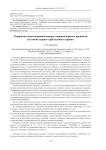
Статья научная
In this material development stages of the two-fuel combustion chamber for the HK-16-18CT engine are presented. Calculation of processes on the basis of the theory of turbulent burning is made. One of competitive advantages of stationary gas-turbine installation is the possibility of work on two types of fuel: on diesel and on gaseous. Therefore creation of the two-fuel combustion chamber is relevant. The designing process of the two-fuel combustion chamber consists of several stages. At the first stage the nozzle is developed. It is equipped with two internal fuel channels. Then the front device is designed. in it nozzles are placed in two ranks. This device is equipped with two separate fuel collectors. It contains cavities for a fuel supply to two channels of nozzles. Such constructive decision allows to carry out switching of one type of fuel to another without stopping operation of the engine. As a prototype for distribution of air on length of a spherical pipe the combustion chamber of the NK-8-2U engine is taken. Calculation of processes in the combustion chamber was carried out on the basis of the theory of turbulent burning. During calculation such parameters as the normal speed of burning, the pulsation speed, coefficient of turbulent exchange, scale of turbulence and intensity of turbulence are determined. The equation of thermal balance for determination of temperature in the considered area at combustion of natural gas and diesel fuel is created. It is considered what in one case is spent warmly going for evaporation of liquid fuel, in other case it is not necessary. For calculation of formation of nitrogen oxides Ya. B. Zeldovich's theory of thermal oxidation of nitrogen is used by oxygen. Emissions of carbon monoxide are determined by an empirical formula From gasdynamic calculation of the HK-16-18CT engine parameters on an entrance to the combustion chamber on various operating modes at combustion of natural gas are known. Calculation for definition of a necessary consumption of diesel fuel for power setting at preservation of temperature at the exit is executed from the combustion chamber. By results of calculation the schedule of emission of harmful substances from power setting on gas and diesel fuels is constructed. The comparative schedule of dependence of completeness of combustion of fuel on power setting is constructed. Settlement emissions of harmful substances of the developed combustion chamber in the range of operation of the engine on power from 0,7Ne to 1 Ne for liquid fuel: NOx15%O2 does not exceed 250 mg/m3, СO15%О2 does not exceed 300 mg/m3; for gaseous NOx15%O2 fuel does not exceed 120 mg/m3, СO15%О2 does not exceed 150 mg/m3.
Бесплатно
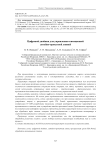
Digital twin for combined casting and rolling line control
Статья научная
Aluminum alloys of all kinds are widely used in rocket and other space vehicles construction and operation - in structural elements, communication lines and power supply units. The parameters of alloys processing operations must be strictly maintained in order to exclude de-fects and obtain products of the required quality. Technologies of metal processing in space engineer-ing include such operations as casting, rolling and forming; continuous melt-crystallization-forming lines can also be used, which imposes additional requirements on the integrated control of such a line. The article is focused on the design of a digital twin to be used for controlling a combined casting and rolling complex. Basing on the previously worked-out mathematical models of the units and com-ponents of the complex (furnace, tray, mold, forming unit, rectifying and cooling assembly, spools), a special program has been designed in the TIA Portal software environment using the S7-1200 micro-processor controller, which simulates the parameter changes of both rolled metal and casting and rolling line units. The article also presents the structure and the user interface of the specified pro-gram. There are calculations of the technological cycle parameters for processing of three alloys - that gives an understanding of temperatures and speeds distribution in the rolled metal at each unit of the line. The program can be used for production lines and complexes both in preliminary processing calcu-lations for various alloys (to select the necessary control options) and during the process itself as part of the applied process control system (to confirm the cooling parameters and casting speed).
Бесплатно
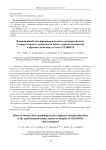
Статья научная
The article contains the results of research on the effect of abrasive flow machining on the roughness and microhardness of the surface of small channels (holes) in samples of workpieces made of 12X18H10T steel. Empirical dependencies of the change in roughness and microhardness of the surface of a small channel on the degree of filling of the working medium with a plasticizer and the shear pressure of the hydraulic system with the extreme of these functions in the studied area are obtained. Based on these dependencies, the composition of the working environment was selected: the degree of filling of the work-ing media base (with a constant content of white electro corundum – 30 %) with a plasticizer in the form of diamond paste (ACN 60/40 BOM Г) Ka 40 % and CKT rubber 30 %, respectively. As a result of abrasive flow machining, it was possible to reduce the roughness of the surface layer from Ra = 0.49…0.62 µm to Ra = 0.047…0.06 µm, and also to increase the microhardness of the surface from h = 188…192 HV to h = 213…220 HV. The thickness of the hardened layer is ≈ 7.24 µm. Analysis of surface profilograms shows that as a result of abrasive flow machining, both the height roughness parameters (average – Ra, Rz, Rp; maximum – Rmax) and the depth roughness parameters (Rk) were significantly reduced. Using electron microscopy (SEM MAG), a qualitative assessment of the structure of the surface layer of the small channel was carried out. The obtained results show good machinability by abrasive flow of austenitic steel blanks, in particular 12X18H10T steel.
Бесплатно
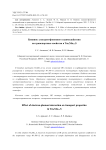
Effect of electron-phonon interaction on transport properties in TmxMn1-xS
Статья научная
In solid solutions TmxMn1-xS, based on measurements of IR spectra and thermal expansion coefficient in the temperature range 80–500 K, the temperatures of sample deformation and disappearance of the absorption intensity of IR spectra at some frequencies are established. Anomalies in the temperature behavior of the electrical resistance are found, the sign of the current carriers and the mobility are determined from the Hall coefficient. The correlation between the temperatures of coefficient of electrical resistance and lattice deformation has been determined. A model of lattice polarons is proposed. The spectrum of electronic excitations and the density of electronic states in the interaction of electrons with flexural and tensile modes of the octahedron are calculated in the random phase approximation.
Бесплатно

